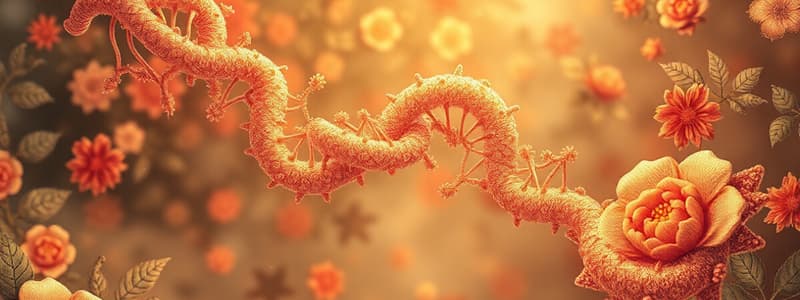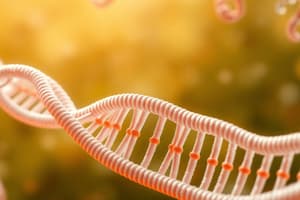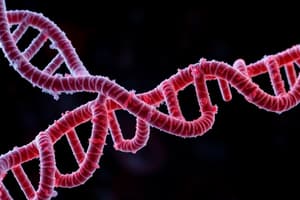Podcast
Questions and Answers
At which levels can gene expression be regulated?
At which levels can gene expression be regulated?
- Transcription only
- Multiple levels including transcription, translation, and post-translation (correct)
- Post-translation only
- Translation only
A promoter is a DNA sequence located downstream of the transcription start site.
A promoter is a DNA sequence located downstream of the transcription start site.
False (B)
What type of molecule are transcriptional regulators?
What type of molecule are transcriptional regulators?
proteins
The Lac operon is regulated in ______.
The Lac operon is regulated in ______.
What is the primary role of enhancers in transcriptional regulation?
What is the primary role of enhancers in transcriptional regulation?
Eukaryotic enhancers can only be bound by a single transcriptional regulator.
Eukaryotic enhancers can only be bound by a single transcriptional regulator.
What is the name given to a cluster of bacterial genes transcribed from a single promoter?
What is the name given to a cluster of bacterial genes transcribed from a single promoter?
The expression of an operon is controlled by a regulatory sequence called the ______.
The expression of an operon is controlled by a regulatory sequence called the ______.
When is the expression of genes in the Lac operon most efficient?
When is the expression of genes in the Lac operon most efficient?
The Lac repressor inhibits transcription when lactose is present.
The Lac repressor inhibits transcription when lactose is present.
What molecule is the indicator for when the Lac repressor is not bound to the operator?
What molecule is the indicator for when the Lac repressor is not bound to the operator?
In the absence of glucose, what activates transcription?
In the absence of glucose, what activates transcription?
Eukaryotic cells contain one type of RNA polymerase.
Eukaryotic cells contain one type of RNA polymerase.
In eukaryotes, RNA polymerase ______ transcribes all mRNAs.
In eukaryotes, RNA polymerase ______ transcribes all mRNAs.
Where are enhancers typically located relative to the genes they regulate?
Where are enhancers typically located relative to the genes they regulate?
What is a 'Mediator' in the context of eukaryotic transcription?
What is a 'Mediator' in the context of eukaryotic transcription?
Enhancers can only be bound by a single transcriptional regulator.
Enhancers can only be bound by a single transcriptional regulator.
What ensures precise regulation of gene expression?
What ensures precise regulation of gene expression?
Control of ______ is at the heart of development.
Control of ______ is at the heart of development.
Where does RNA polymerase bind?
Where does RNA polymerase bind?
Match the following mRNA process with the corresponding numbers in the image:
Match the following mRNA process with the corresponding numbers in the image:
Where are transcriptional regulators bind?
Where are transcriptional regulators bind?
Activators work to block the binding of RNA polymerase to the promoter.
Activators work to block the binding of RNA polymerase to the promoter.
A cluster of genes that function in the same pathway are often organized into an ______.
A cluster of genes that function in the same pathway are often organized into an ______.
What condition must exist for the Lac operon to be expressed?
What condition must exist for the Lac operon to be expressed?
Which RNA polymerase is involved in the transcription of protein-coding mRNAs?
Which RNA polymerase is involved in the transcription of protein-coding mRNAs?
RNA polymerase II binding to the promoter region is sufficient to activate transcription
RNA polymerase II binding to the promoter region is sufficient to activate transcription
Transcriptional regulators bind to DNA sequences called ______.
Transcriptional regulators bind to DNA sequences called ______.
What is a Terminator?
What is a Terminator?
Where is promoter located?
Where is promoter located?
Unused genes are mutated or destroyed.
Unused genes are mutated or destroyed.
Which of the following are properties of transcription factors?
Which of the following are properties of transcription factors?
Transcription factors are also known as ______.
Transcription factors are also known as ______.
How do transcription regulators bind to DNA?
How do transcription regulators bind to DNA?
In the absence of lactose, the Lac repressor enhances transcription.
In the absence of lactose, the Lac repressor enhances transcription.
What factors ensure the expression of Shh in the limb?
What factors ensure the expression of Shh in the limb?
Multiple transcriptional regulators (activators and repressors) ensure precise ______.
Multiple transcriptional regulators (activators and repressors) ensure precise ______.
What does 'ectopic expression' mean?
What does 'ectopic expression' mean?
Eukaryotic transcription is less complex than prokaryotic transcription.
Eukaryotic transcription is less complex than prokaryotic transcription.
The genome is constant in what type of cells?
The genome is constant in what type of cells?
Flashcards
Gene expression
Gene expression
The process by which the information encoded in a DNA sequence is translated into a product (usually a protein).
Differential gene expression
Differential gene expression
The genome is constant in all somatic cells, but only a small proportion is expressed in any cell type. Unused genes retain potential.
Promoter
Promoter
A region of DNA where RNA polymerase binds to initiate transcription.
Terminator
Terminator
Signup and view all the flashcards
Transcriptional regulators
Transcriptional regulators
Signup and view all the flashcards
Operon
Operon
Signup and view all the flashcards
Operator
Operator
Signup and view all the flashcards
Lac operon
Lac operon
Signup and view all the flashcards
Lac repressor
Lac repressor
Signup and view all the flashcards
CAP activator
CAP activator
Signup and view all the flashcards
Enhancers
Enhancers
Signup and view all the flashcards
Mediator
Mediator
Signup and view all the flashcards
Ectopic expression
Ectopic expression
Signup and view all the flashcards
Regulatory DNA sequences
Regulatory DNA sequences
Signup and view all the flashcards
Transcription regulators
Transcription regulators
Signup and view all the flashcards
DNA binding specificity
DNA binding specificity
Signup and view all the flashcards
Lac operon condition
Lac operon condition
Signup and view all the flashcards
Looping of DNA
Looping of DNA
Signup and view all the flashcards
Enhancer influence
Enhancer influence
Signup and view all the flashcards
Study Notes
- Gene expression can be regulated at many levels.
- Promoter: A region of DNA adjacent and upstream of a gene's transcriptional start site where RNA polymerase binds.
- Transcriptional regulators are DNA-binding proteins that can act as activators or repressors.
- Understanding how the Lac operon is regulated in bacteria is important
- Appreciate the complexity of eukaryotic transcriptional regulation.
- Enhancers are DNA sequences that control gene expression.
- Eukaryotic enhancers can be bound by multiple transcriptional regulators, including activators and repressors.
- General principles of transcription and its regulation are core concepts.
- Transcriptional regulation in bacteria and eukaryotes is distinct.
- The central dogma involves transcription of DNA into mRNA and translation of mRNA into protein.
- Gene expression is the process by which DNA sequence information is translated into a product, often a protein.
- The genome is constant in all somatic cells, but only a small proportion is expressed in any given cell type.
- Unused, untranscribed genes retain the potential to be expressed.
- Gene expression can be regulated at many levels, including transcriptional control, RNA processing control, RNA transport and localization control, mRNA degradation control, translation control, protein activity control
- Regulation at the RNA transcript level is relatively slow-acting and a common control point for long-term regulation.
- Protein activity control is fast-acting and readily reversible.
- In prokaryotes, transcription involves a coding strand and a template strand.
- Promoters are upstream sequences recognized by RNA polymerase to initiate transcription, but are not transcribed into mRNA
- Terminators are sequences recognized by RNA polymerase to stop transcription, near the stop site in the mRNA
- Promoters vary in strength of binding to RNA polymerase, influencing gene expression levels.
- Promoter activity is inhibited by transcriptional repressors and enhanced by transcriptional activators.
- Activators and repressors work together to allow sensitive transcriptional regulation.
- Transcriptional activators or repressors are transcription regulators or transcription factors.
- DNA-binding domains of transcription factors bind to unique DNA sequences with varying affinities.
- Different DNA binding domains allow for binding to different DNA sequences, ensuring specificity.
- An operon is a cluster of bacterial genes transcribed from a single promoter.
- The operator is a regulatory sequence that controls operon expression; it binds transcription regulator proteins.
- E. coli use glucose as an energy source, but can break down lactose if glucose is unavailable.
- The Lac operon genes enable E. coli to utilize lactose.
- The Lac operon is expressed when glucose is unavailable and lactose is present.
Lac Operon Regulation
- When glucose and lactose are both present, the Lac genes are off
- When only glucose is present, the Lac genes are off
- When neither glucose or lactose are present, the Lac genes are off
- When only lactose is present, the Lac genes are on
- The Lac repressor inhibits transcription when lactose is absent
- Allolactose, a lactose metabolite, inactivates the repressor when lactose is present and its levels reflect lactose levels
- The Lac promoter is weak, so even without the repressor, transcription isn't sufficient.
- CAP activates transcription when glucose is absent; when glucose levels are low, cAMP levels increase.
- Activators and repressors work together to regulate the Lac operon.
Eukaryotic Transcription
- Eukaryotic transcription is more complex than prokaryotic transcription.
- Eukaryotic cells have three distinct RNA polymerases: I, II, and III.
- RNA polymerase II transcribes mRNA (protein-encoding genes).
- Specific transcription activators or repressors bind to DNA sequences (enhancers) far from the promoter.
- Enhancers are regulatory DNA sequences bound by transcriptional regulators, usually activators.
- Enhancers function to allow transcription of a given gene in specific cells or developmental stages.
- Enhancers can be located far from the transcription start site.
- Mediator is a 24-subunit complex that acts as an intermediary between transcription regulators and RNA polymerase.
- DNA looping brings enhancers into proximity with the promoter and RNA polymerase
- Enhancers can be bound by multiple transcriptional regulators.
- Combined actions of multiple transcriptional regulators ensure precise gene expression regulation.
- Shh (sonic hedgehog) regulates anterior-posterior patterning of the limb and expression of Shh in the limb is controlled by a limb-specific enhancer.
- Ectopic expression is the expression of a gene in a place or time where it is not normally expressed. Ectopic expression of Shh causes extra digit formation.
- A single base-pair change can cause ectopic Shh expression in the limb, leading to digit duplication in mice.
- The Shh limb enhancer is conserved in mouse, human, and fish, but not in limbless reptiles.
- Loss of the limb enhancer for Shh is associated with the loss of limb in advanced snakes.
Studying That Suits You
Use AI to generate personalized quizzes and flashcards to suit your learning preferences.




